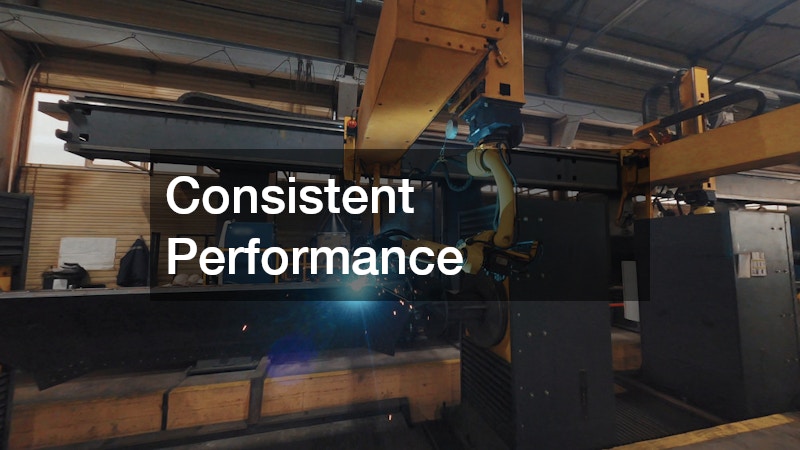Discover how robotic welding is transforming industries, enhancing productivity, and improving the quality of welding processes. Across various sectors, robotic welding has become a cornerstone in advancing manufacturing capabilities. By leveraging cutting-edge technology, businesses are pushing the boundaries of what is possible in terms of speed and accuracy.
Reduction in Human Error
The implementation of robotic systems significantly minimizes human errors that are prevalent in manual welding processes. Precision engineering in robotics ensures every weld is performed with exact specifications, drastically reducing the incidence of defects. This reduction in errors translates to a more efficient workflow with less time wasted in reworking faulty welds.
Robotic welding utilizes sophisticated algorithms and sensors to continuously monitor and adjust the welding process. This adaptability allows robots to maintain high-quality craftsmanship without the fatigue that plagues human operators. Consequently, robotic systems offer unparalleled consistency and reliability over extended periods.
24/7 Operation Capabilities
Robotic welding systems can operate continuously without breaks, dramatically enhancing production output. Unlike human labor, robots do not require downtime, allowing manufacturers to achieve higher throughput in less time. This capability ensures businesses can meet tight deadlines and handle greater demand effectively.
With the ability to work around the clock, robotic welding maximizes equipment utilization rates. This efficiency leads to faster return on investment as the machinery works tirelessly, providing consistent production metrics. Such capabilities ease the strain on business operations, fostering an environment of seamless production flow.
Faster Welding Speeds
Robotic welding achieves greater speed, significantly reducing production time and overall costs. High-speed automation allows manufacturers to produce more units within the same timeframe compared to manual processes. This speed advantage ensures businesses can remain competitive in fast-paced markets.
Investments in robotic systems often result in economic benefits due to the increased volume of output and decreased unit costs. As production rates soar, the per-unit cost of goods declines, providing a competitive edge in price-sensitive markets. This scenario is particularly advantageous for high-volume manufacturing sectors.
Advanced Sensor Technology
Modern robotic welding processes are equipped with advanced sensor technologies that optimize weld accuracy. Through real-time monitoring and adaptive feedback systems, robots can make instantaneous adjustments to maintain consistent weld quality. This precision reduces variability, ensuring high standards are met consistently in production.
Sensors play a crucial role in detecting anomalies during the welding process, automatically adjusting parameters to rectify any discrepancies. This technology leads to fewer defects and a significant reduction in waste materials. Improved sensor technology aligns with sustainable manufacturing practices by minimizing resource consumption.
Consistent Performance
Robotic welding ensures consistent performance, significantly reducing weld variability and rework rates. Automated systems deliver uniform quality across each weld, eliminating the inconsistencies often associated with manual processes. This reliability is critical in applications where precision is paramount.
The repetitive accuracy of robots allows for a streamlined quality assurance process, resulting in fewer deviations from product specifications. High consistency levels enhance product reliability and customer satisfaction. Consequently, robotic welding systems are invaluable in industries with rigorous compliance standards.
Precision Control Systems
Robotic systems utilize precision control systems to ensure optimal welding results. These systems meticulously manage welding parameters such as speed, angle, and temperature for each job. Precision control ensures each weld meets exacting specifications, crucial for high-quality output.
The implementation of precision control systems allows manufacturers to navigate tight tolerances in challenging applications. This precision leads to superior product quality, essential for sectors like automotive and aerospace that demand flawless manufacturing processes. Precision control underpins the ability of robotics to deliver superior craftsmanship consistently.
Infrastructure and ROI
Implementing robotic welding requires careful consideration of infrastructure improvements and the subsequent return on investment (ROI). Before integration, facilities may need to upgrade power supplies, floor layouts, and network capabilities to accommodate robotic systems. Such investments are justified by the cumulative long-term benefits and efficiency gains.
Evaluating ROI involves analyzing cost savings from increased productivity and reduced materials wastage. The upfront investment might be significant, but the economic advantages become apparent as robots enhance throughput and diminish production inconsistencies. With strategic planning, companies often see a rapid return, ultimately boosting profitability.
Operator Training
Comprehensive operator training is essential to effectively managing and maintaining robotic welding equipment. Skilled operators can maximize the potential of robotic systems, ensuring error-free setup and optimal performance. Training programs bridge the knowledge gap, increasing the competency levels necessary for high-tech machinery handling.
Well-trained operators are pivotal in identifying and troubleshooting system irregularities swiftly. Proficiency in programming and maintenance significantly mitigates downtime, ensuring seamless operations. Investing in training reflects a commitment to not only advanced technology but also human capital development.
Integration with Existing Processes
Integration of robotic welding systems into existing manufacturing workflows requires strategic planning. Companies must assess compatibility with current systems and determine how robotics will complement traditional methods without disruption. This integration is key to realizing the full potential of automated welding processes.
In summary, robotic welding significantly enhances efficiency and precision across industries, offering substantial improvements in quality and productivity. The strategic implementation of these systems is transforming manufacturing landscapes, cementing their pivotal role in modern production environments. Future developments promise even greater integration and innovation, establishing robotics as a cornerstone of industrial advancement.
